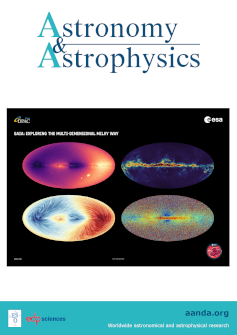Observation of the Crab Nebula with the Single-Mirror Small-Size Telescope stereoscopic system at low altitude
IF 5.8
2区 物理与天体物理
Q1 ASTRONOMY & ASTROPHYSICS
引用次数: 0
Abstract
The Single-Mirror Small-Size Telescope (SST-1M) stereoscopic system is composed of two Imaging Atmospheric Cherenkov Telescopes (IACTs) designed to deliver optimal performance for gamma-ray astronomy in the multi-TeV energy range. It features a 4-m diameter tessellated mirror dish and an innovative SiPM-based camera. Its optical system features a 4-m diameter spherical mirror dish based on the Davies-Cotton design, maintaining a good image quality over a large field of view (FoV), while minimizing optical aberrations. In 2022, two SST-1M telescopes were installed at the Ondřejov Observatory, Czech Republic at an altitude of 510 meters above sea level, collecting data for commissioning and astronomical observations since then. We present the first SST-1M observations of the Crab Nebula, conducted between September 2023 and March 2024 in both mono and stereoscopic modes. During this observation period, 46 hours for the SST-1M-1 and 52 hours for the SST-1M-2 were collected (of which 33 hours were in stereoscopic mode). In this work, we used the Crab Nebula observation to validate the expected performance of the instrument, as evaluated by Monte Carlo (MC) simulations that were carefully tuned to account for instrumental and atmospheric effects. We determined that the energy threshold at the analysis level for the zenith angles below 30° is 1 TeV for mono mode and 1.3 TeV for stereo mode. The energy and angular resolutions were approximately 20% and 0.18° for mono mode and 10% and 0.10° for stereo mode, respectively. We present an off-axis performance assessment of the instrument and a detailed study of the systematic uncertainties. The full simulation results for the telescope and its camera are compared to the data for the first time, enabling a deeper understanding of the SST-1M array performance.低空单镜小口径望远镜立体系统对蟹状星云的观测
单镜小尺寸望远镜(SST-1M)立体系统由两台成像大气切伦科夫望远镜(IACTs)组成,旨在为多tev能量范围内的伽马射线天文学提供最佳性能。它的特点是直径4米的镶嵌镜面和一个创新的基于sipm的相机。它的光学系统采用了一个直径4米的球形镜面盘,基于戴维斯-科顿设计,在大视场(FoV)上保持良好的图像质量,同时最大限度地减少光学像差。2022年,两台SST-1M望远镜安装在捷克共和国Ondřejov天文台,海拔510米,为调试和天文观测收集数据。我们在2023年9月至2024年3月期间对蟹状星云进行了单面和立体模式的首次SST-1M观测。在此观测期内,共收集了SST-1M-1和SST-1M-2的46小时和52小时,其中33小时为立体模式。在这项工作中,我们使用蟹状星云观测来验证仪器的预期性能,通过蒙特卡罗(MC)模拟进行评估,该模拟经过仔细调整,以考虑仪器和大气的影响。我们确定了天顶角低于30°的分析水平的能量阈值,单声道模式为1 TeV,立体模式为1.3 TeV。单声道模式的能量分辨率约为20%,角分辨率约为0.18°,立体模式的能量分辨率约为10%,角分辨率约为0.10°。我们提出了仪器的离轴性能评估和系统不确定度的详细研究。首次将望远镜及其相机的完整模拟结果与数据进行比较,使人们能够更深入地了解SST-1M阵列的性能。
本文章由计算机程序翻译,如有差异,请以英文原文为准。
求助全文
约1分钟内获得全文
求助全文
来源期刊

Astronomy & Astrophysics
地学天文-天文与天体物理
CiteScore
10.20
自引率
27.70%
发文量
2105
审稿时长
1-2 weeks
期刊介绍:
Astronomy & Astrophysics is an international Journal that publishes papers on all aspects of astronomy and astrophysics (theoretical, observational, and instrumental) independently of the techniques used to obtain the results.
 求助内容:
求助内容: 应助结果提醒方式:
应助结果提醒方式:


